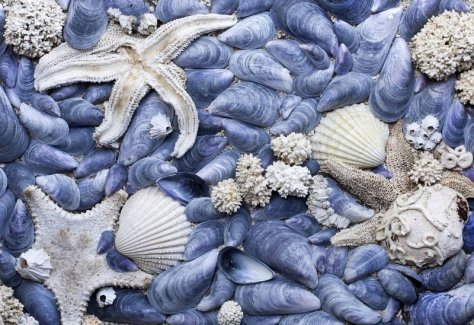Colours and patterns 65° 53’ Norwegian coast. VOL 1
Text and photos Ingrid Maasik
Translation: Liis
On the Helgeland coast in North Norway the most spell-binding thing for me is that the coast is alive. It lives with the rhythm of the tides, the islands of rock strips rise and fall as the rib cage of the land. Low tide leaves mussels, sea urchin and crab shells and starfish lying about, and the gulls carry shells and sea slug houses never seen before up on the rocks.
For years I collected them and carried them home, at first indiscriminately, later only the most interesting specimens, cleaned them and stored them. Finally so many had accumulated that I started to put them systematically in boxes. Only then I noticed how variable the crusts of one sea creature species could be. For instance the stripe on the cases of red sea urchins could be orange, red or dark violet, a white band and dots in between. Even the shells of whelks that at a first glance look uniformly grey-pastel-tinted have different patterns and nuances. The carapaces that have covered the head and abdomen of the shore crabs have all kinds of colours, from bleached white to dark green and red, only the similar pattern looks as if it had been dotted on with the tip of a paintbrush.
Somehow I paced them beside each other at random, then fitted together, and so the first photo was born, of the shells of red sea urchins. The next composition was of mussels, then sea slugs or nudibranches, and then I started putting together different species, blue-and-white compositions were born, and finally when very much stuff had collected I started to make compositions in colours. Finally out of it grew a sale of interior decoration photos.
Making such an image is a long-term process. I collect, brush and wash clean. I find out what fits together. Putting them out in a frame norm ally takes half a day but if material is in short supply or inspiration disappears or everyday forces itself in, I go on later. Sometimes it happens that the image of the final pattern does not suit and I start from the beginning.
When the pattern is ready I check everything with a magnifying glass and remove dust and dirt. To spot the threads of spiders and hairs is the most difficult. They can be taken out in the post-processing but it is more to the purpose to take the photo cleanly.
After this I place the frame on the floor of the old woodshed where the light sometimes is very good in the afternoons and position the camera. The tripod arm is horizontally fixable which is ideal for making such photos. The floor isn’t level, so I take care that the lens is perfectly parallel with the surface to be photographed. I check that the ISO is 100. I put in the aperture and exposure. I focus manually. I test whether and in what to mirror the light. Now is the time to check if the sun is in a suitable position and from where and how fast clouds move. In working with natural light clouds are reflectors and diffusers. The moment approaches, I spray the shells and cases selectively with water. I wait until the water is absorbed, dry off some too wet spots quickly and – holding my breath – take the photo!
Now the moment of truth approaches: on the computer screen it becomes clear if the image is sharp, if the composition is still attractive and that nothing untoward is in sight anywhere. Often places have to be changed between the shells, the frame turned into a better angle to the light or other similar things. A haunting feeling that somehow it could have been better always remains.
But my neighbour said, Oh shit, I have never seen such things before and probably won’t see either I guess, bought it and set up on his wall.
Ingrid Maasiku näitus Lihula mõisa peahoones on avatud kuni 30.novembrini 2014.
Autori pilte saab näha: LINK










